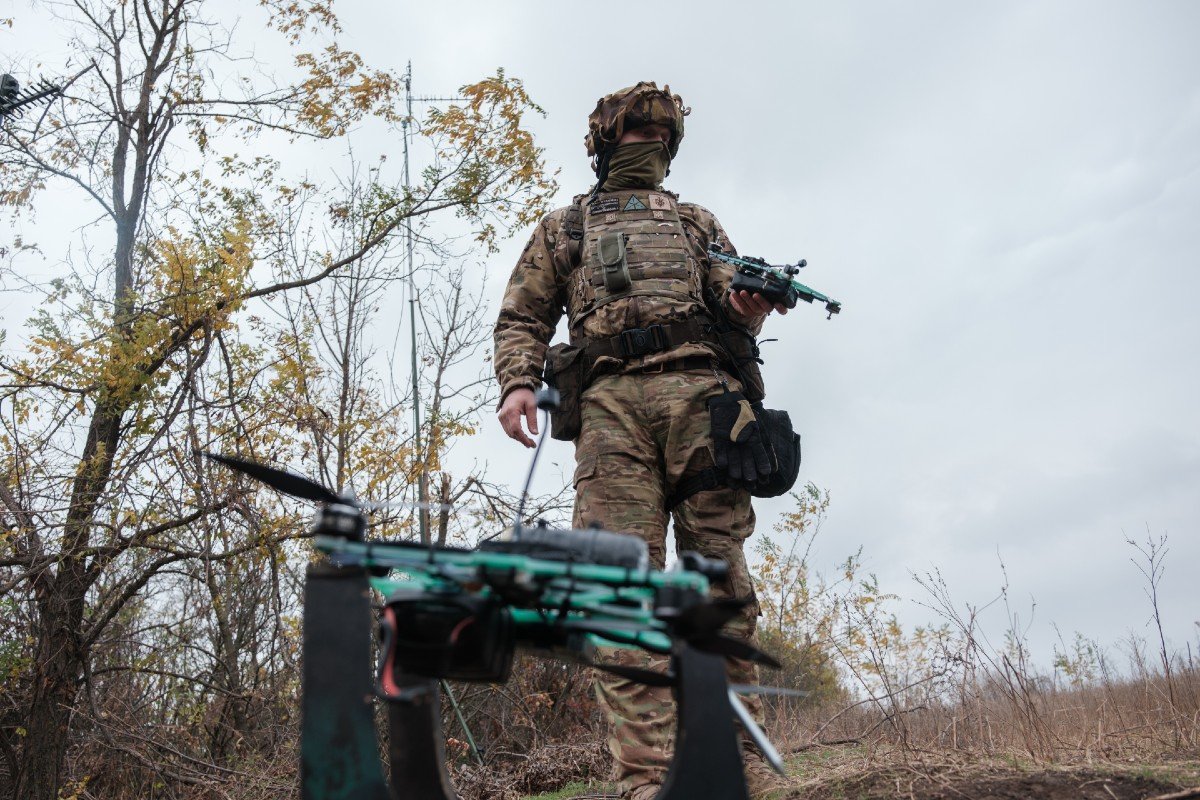Ellie Cook
First-person view (FPV) drones are now becoming more useful to Ukraine's front-line fighters than artillery, according to Kyiv's drone tsar, as Kyiv ploughs on with efforts to put more and more of the vital machines in the air.
The FPV uncrewed vehicles have quickly become "a game-changer" on the Ukrainian battlefield, taking out masses of Russian hardware, said Mykhailo Fedorov, Kyiv's Minister of Digital Transformation, who is at the helm of Ukraine's drone efforts against Russia.
"They work sometimes even more efficiently than artillery," he told Newsweek. "So, FPV drones are indeed a tech revolution, even though the tech itself is quite easy. But it turned out to be very efficient."
FPV drones quickly became almost emblematic of Ukraine's efforts with unmanned aerial vehicles (UAVs). They can be used to record dramatic battlefield footage where the drone careens towards Russian vehicles before exploding, or deployed as reconnaissance tools to guide artillery strikes.
Artillery has also been a staple of the war effort, and a constant feature of Western military aid packages destined for Kyiv's troops.
FPV drones certainly have appeared to work better in some instances than artillery for Ukraine, agreed U.K-based drone expert, Steve Wright.
"In many ways, using battlefield FPV drones is a continuation of a trend, particularly by the West, of moving to more and more tight targeting of explosives," he told Newsweek.

A Ukrainian soldier on October 26, 2023, in Zaporizhzhia Oblast, Ukraine. First-person-view uncrewed vehicles have quickly become "a game changer" on the battlefield, said Mykhailo Fedorov.
The explosive, kamikaze FPV drones are cheap, often using commercially bought parts, and can pack a real punch against an enemy's vehicles or its personnel.
And Ukraine is stocking up. Kyiv has run a series of fundraisers, scooping resources into a pot destined to buy more FPV drones.
Kyiv's United24 platform, which was launched by Ukrainian President Volodymyr Zelensky to collect donations for the war effort, took a handful of days earlier this month to drum up enough money— around $6.3 million—to buy 10,000 FPV attack drones under a joint venture with the Ukraine-based Come Back Alive Foundation and Ukraine's Monobank, dubbed Operation Unity.
The drones, bought abroad and then fitted with ammunition inside Ukraine, have a range of up to 10 kilometers (6.2 miles), Fedorov said.
"They will be deployed along all the front line," including by the Ukrainian security service, he said. Newsweek understands that the drones will be primarily used in mainland Ukraine, rather than for operations involving Russian-annexed Crimea, and many have already reached their assigned units.
"These drones are meant to destroy enemies and hardware right on the battlefield," Fedorov said.
"FPV drones have proven to be an effective weapon," said Colonel Oleksandr Shtupun, a spokesperson for Ukraine's Tavria grouping of forces that covers the heavily fortified Ukrainian town of Avdiivka, a hotspot of clashes in Donetsk.
"But not all combat tasks can be performed with their help," he told Newsweek. "Aviation, artillery, and means of radio-electronic warfare are needed," he said, adding Ukraine needed more "effective countermeasures against enemy FPV drones and other unmanned aerial vehicles."
Ukraine expected to raise the funds "rather quickly," but not quite as rapidly as it did, Fedorov said. A second round of fundraising for Operation Unity later took just three days to raise enough money for 5,000 more FPV drones. More than 224,059 donors from Ukraine and 59 other countries contributed to the funds "for a New Year's fireworks show for Ukraine's enemies," United24 said.
The funds will buy 3,000 FPV drones kitted out with thermal cameras, plus 2,000 more with daytime cameras, with a range up to 22 kilometers, or just over 13 miles. An initial batch of 3,000 drones will arrive in Ukraine shortly after the new year, with a second batch following in February 2024, according to United24.
Ukraine dominated FPV manufacturing earlier this year, but Russia has since boosted its own programs and sent large numbers of the unmanned vehicles to the front lines.
"Multiple Russian volunteer, state and affiliated manufacturing efforts have significantly ramped up FPV development and shipped large quantities to the front," Samuel Bendett of the Center for Naval Analyses, a U.S. think tank, previously told Newsweek. "It's highly likely that these efforts combined are providing the Russian military with tens of thousands of FPVs a month."
And Ukraine is getting through tens of thousands of drones each month, Fedorov told Newsweek, although he declined to provide further details about how many Kyiv loses.
Russia's FPV development has probably "grown exponentially," Bendett said, although it is difficult to determine how many FPV drones are present on, and above, the battlefield. Ukraine's military is increasingly reporting more Russian drones operating in larger numbers across certain parts of the front lines, he added.
Two Ukrainian soldiers fighting around the embattled Donetsk city of Avdiivka told Newsweek last week that Russia had increased its use of FPV drones in the region, which Moscow is attempting to encircle at an excruciating cost to its military.
No comments:
Post a Comment